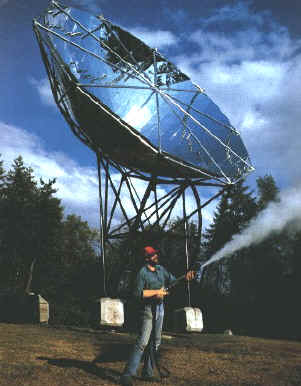
 |
Humans have used sunlight to perform a variety of tasks for centuries, but the concept of solar thermal energy really got cooking in 1767 when the Swiss scientist Horace de Saussure invented the world's first solar collector, or "hot box". Renowned astronomer Sir John Herschel used solar hot boxes to cook food during his expedition to Southern Africa in the 1830's. Solar thermal energy became important in parts of Africa for cooking and water distillation. Solar thermal systems concentrate heat and transfer it to a fluid. The heat is then used to warm buildings, heat water, generate electricity, dry crops or destroy dangerous waste. Solar Thermal Collectors are divided into three categories:
Low-temperature collectors provide low grade heat, less than 110 Fahrenheit, through either metallic or nonmetallic absorbers for applications such as swimming pool heating and low-grade water and space heating.
Medium-temperature collectors provide medium to high-grade heat (greater than 110 Fahrenheit, usually 140 to 180 Fahrenheit), either through glazed flat-plate collectors using air or liquid as the heat transfer medium or through concentrator collectors that concentrate the heat to levels greater than "one sun." These include evacuated tube collectors, and are most commonly used for residential hot water heating.
High-temperature collectors are parabolic dish or trough collectors primarily used by independent power producers to generate electricity for the electric grid.
Concentrating Solar Thermal Systems use three different types of concentrators:
Central receiver systems use heliostats (highly reflective mirrors) that track the sun and focus it on a central receiver.
Parabolic dish systems use dish-shaped reflectors to concentrate sunlight on a receiver mounted above the dish at its focal point.
Parabolic trough systems use parabolic reflectors in a trough configuration to focus sunlight on a tube running the length of the trough.

Technology Examples
Pool Heating - These systems can be as simple as water running through a black hose and specially manufactured systems are more efficient modifications on this concept.
Domestic Hot Water - These are what you are most likely seeing on all those houses where you live. They come in a variety of styles but all of them collect heat in some liquid, usually water or water mixed with an anti-freeze, that runs through pipes in a box with glass on the front. The box helps keep temperatures inside around the pipes higher so more heat transfers to the liquid. The hot liquid gives its heat to another loop of pipes through a heat exchanger and this new loop is used for home hot water use or heating the space with a radiator.
Commercial Scale - These can be designed to heat or cool a large commercial space or to make steam which can turn a turbine to make electricity.